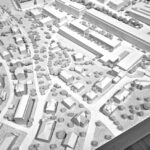Mysterious Structure Spotted Near Egypt’s Pyramids on Google Maps Sparks Bizarre Theories

Just a short distance from the timeless grandeur of Egypt’s Giza pyramids, a modern-day enigma has materialized on the digital landscape of Google Maps. An unusual, precisely shaped structure, accompanied by a deliberate arrangement of smaller buildings, has been spotted in the desert sands. Its exact coordinates, 29°54’23″N 31°08’02” E, mark the location of a discovery that has ignited a firestorm of online speculation. Strikingly absent of any official label on popular mapping platforms, this curious complex has become a blank canvas onto which many theories have been projected.
Theories surrounding this desert anomaly range from the fantastical to the functional, each attempting to decipher the purpose of this intriguing formation. Whispers of ancient technologies and otherworldly connections mingle with more pragmatic suggestions of hidden historical sites or contemporary installations. The very shape of the structure and its deliberate positioning about one of the world’s most iconic landmarks only deepens the mystery.
This unexpected find highlights the power of accessible satellite imagery to unveil hidden aspects of our world, sparking curiosity and prompting a collective effort to understand the unfamiliar. Why does this particular structure, so close to such ancient wonders, remain unlabeled and unexplained? What could its purpose be, and why has it captured the imaginations of so many online explorers? Join us as we delve into the details of this fascinating discovery and explore the leading theories attempting to unravel the secrets held within the sands near Egypt’s famed pyramids.
The Discovery in Detail
Satellite imagery reveals a distinctive horseshoe-shaped structure with another formation between its pointed ends. Surrounding this central feature are oddly shaped buildings positioned at the top and sides, creating an undeniably deliberate pattern. Located about a 24-minute drive from the Great Pyramid, it’s proximity to ancient wonders adds to its mysterious appeal.
What makes this discovery particularly interesting is its precise positioning, according to some observers, it is exactly five miles south of Khufu’s pyramid. Whether this measurement is coincidental or intentional remains unclear, but precision has always been associated with pyramid construction, fueling speculative fires.
Unlike many regional structures, this complex lacks a clear identification on Google Maps. No roads are labeled leading to it, and no official designation appears when hovering over the location. This information vacuum created perfect conditions for theories to flourish across platforms like Reddit, Twitter, and YouTube, where users debated possible explanations.
Popular Theories and Speculations

Online discussions produced wildly varied explanations for the mystery structure. Science fiction fans immediately connected the horseshoe shape to the fictional “Stargate” device—a portal enabling interstellar travel featured in movies and television series inspired partly by Egyptian iconography. “If stargates were real, they’d probably look something like this,” wrote one enthusiastic commenter.
Archaeological enthusiasts suggested structure might represent “desert kits”—ancient hunting traps believed used for mass hunting in prehistoric times. Others proposed undocumented temple complex or astronomical observation site aligned with specific celestial bodies.
However, most prevalent theories centered on military functions. Reddit users with claimed military backgrounds identified structure as likely housing surface-to-air missiles or radar equipment. “Looks like what our fighter jet bunkers, or missile launchers, look like when they are in storage,” explained one commenter. “You can find similar shapes in Iran, for example.” Others noted that horseshoe shape could serve as blast wall, protecting sensitive equipment or personnel from explosions.
Some fringe theories connected the structure to alleged UFO research or underground bases, suggesting that the horseshoe might conceal the entrance to a vast subterranean complex. These more exotic explanations gained traction, particularly on YouTube channels dedicated to unexplained phenomena and conspiracy theories.
Factual Context About Egypt’s Military History
Far from being unique, this structure fits the pattern of numerous similar installations built throughout Egypt between the 1950s and 1970s. Following the 1952 revolution and subsequent leadership of Gamal Abdel Nasser, Egypt developed close military ties with the Soviet Union, which provided extensive military hardware and technical assistance.
During this period, Egypt established a network of air defense sites specifically designed to protect strategic locations from aerial threats. These installations typically housed Soviet-made surface-to-air missiles (SAMs), primarily SA-2 systems designed to target high-altitude bombers and reconnaissance aircraft. Their distinctive layout—usually featuring a central radar installation surrounded by missile launchers in a specific geometric pattern—bears a striking resemblance to a mysterious structure spotted near pyramids.
Egypt’s location made air defense particularly critical during the Cold War era. Bordering Israel and controlling the Suez Canal, the country held strategic importance that motivated the development of extensive military infrastructure. Many installations remain active or partially decommissioned today, scattered across the Egyptian landscape as relics of different geopolitical eras.
Historical Context of the Giza Pyramids Region

While mystery structures capture the imagination, the Giza plateau remains Egypt’s most famous landmark. Home to three primary pyramids—Khufu (Great Pyramid), Khafre, and Menkaure—the site represents the pinnacle of ancient Egyptian engineering achievement. Built approximately 4,500 years ago during the Fourth Dynasty, these massive structures inspire awe and fascination.
The Great Pyramid stands 480 feet tall with a 750-foot-wide base. It was constructed with an estimated 2.3 million stone blocks averaging 2.5 tons each. The precision of construction remains remarkable even by modern standards, with blocks fitted so tightly that knife blades cannot penetrate joints.
Less appreciated by casual observers is how this region’s strategic value has persisted through millennia. Controlling an elevated plateau overlooking the Nile Valley offered military advantages to numerous civilizations. In the modern era, the area surrounding ancient monuments hosts various military and governmental facilities, making the presence of defense installations entirely logical from a strategic perspective.
This region’s dual nature—simultaneously a tourist destination and a security—sensitive zone—creates inevitable tension between open access and restricted areas, contributing to the mystery surrounding structures like the horseshoe formation spotted on Google Maps.
Similar Cases of Mysterious Google Maps Discoveries
This isn’t the first time unusual structures in Egypt have triggered online speculation. In 2016, another Google Maps discovery featuring two long, pointed buildings surrounded by mysterious circles went viral. Described by some as having a “futuristic design,” it similarly prompted theories ranging from a secret military base to a UFO research facility.
Group calling itself Secureteam10, which focuses on alleged UFO sightings and government cover-ups, highlighted that discovery on YouTube, where commenters compared it to “Star Wars” architecture and debated whether it might be “Egyptian government’s secret UFO base.”
Around the world, satellite imagery regularly reveals structures that appear unusual to untrained observers. From China’s massive radio telescope to Russia’s arctic military bases, unfamiliar geometric patterns viewed from above frequently spark speculation. Military installations prove particularly fertile ground for such theories, as their specialized functions often produce distinctive layouts not immediately recognizable to civilians.
Satellite and aerial imagery accessibility through platforms like Google Maps has democratized the ability to explore remote locations, but without proper context, these discoveries easily lead to misinterpretations. What appears bizarre from above may have a perfectly conventional explanation when viewed from ground level or with appropriate background knowledge.
Egypt and Alien Theories: A Recurring Theme

Egypt has long been the epicenter for theories connecting ancient monuments with extraterrestrial intervention. The precision of pyramid construction, the massive scale of blocks used, and sophisticated astronomical alignments have fueled speculation that ancient Egyptians received otherworldly assistance.
In 2020, Tesla CEO Elon Musk briefly amplified these theories by tweeting “Aliens built the pyramids obv,” drawing swift response from Egyptian officials. Minister of International Cooperation Rania al-Mashat responded with invitation for Musk to visit tombs of pyramid builders, while renowned archaeologist Zahi Hawass dismissed claim as “complete hallucination.”
Archaeological evidence overwhelmingly supports human construction of pyramids. Remains of worker villages, tools, construction ramps, and documentation of building techniques have been extensively documented. Furthermore, archaeological record shows clear evolution of pyramid design, from early step pyramids to later, more sophisticated structures—a progression that reflects human learning and innovation rather than alien technology.
Nevertheless, alien construction theories persist in popular culture, reflecting both genuine wonder at ancient achievements and tendency to underestimate capabilities of past civilizations. Location of mysterious horseshoe structure near pyramids inevitably connects it to this long tradition of extraterrestrial speculation about Egyptian monuments.
What Experts Think the Structure Actually Is

Military analysts and individuals familiar with Cold War-era defense systems have provided the most credible explanation for the mystery structure. Multiple experts identified the formation as an SA-2 surface-to-air missile battery site, specifically designed to split coverage across a particular section of the compass.
“This one appears to be an SA-2 battery, split to better cover a particular section of the compass. The northern three revetments are empty but the southern three appear to have SA-2 launchers in them, but not missiles. The mounds are used to get a bit more height for the radar antenna. Even getting them up 20 or 30 feet above the flat desert makes a huge difference in range.” explained one commenter on Virtual Globetrotting, where same location was discussed back in 2005.
The SA-2 system (Soviet designation S-75 Dvina) was a medium-range, high-altitude air defense system developed in the 1950s. These installations, consisting of radar units and missile launchers, typically featured distinctive geometric layouts designed to optimize defensive coverage while minimizing vulnerability to enemy fire.
A location near Cairo and Giza would make perfect strategic sense for such an installation, providing air defense coverage for Egypt’s capital region and important cultural sites. Similar installations appear throughout Egypt, following standardized Soviet-inspired designs adapted to local terrain conditions.
What Lies Near Egypt’s Pyramids?

The mysterious horseshoe structure near Egypt’s ancient pyramids, while initially sparking visions of Stargates and alien вмешательство, likely represents a relic of a more terrestrial history. The convergence of its distinctive layout with known Soviet-era surface-to-air missile battery designs and Egypt’s strategic military history during the Cold War offers the most compelling explanation. Situated in a region of enduring strategic importance, such a defense installation is far from anomalous, even in the shadow of millennia-old monuments.
This episode underscores the power of readily accessible satellite imagery to ignite curiosity and fuel online speculation. While the democratization of exploration through platforms like Google Maps allows for fascinating discoveries, it also highlights the importance of critical thinking and contextual knowledge. What appears extraordinary from a bird’s-eye view can often be demystified with historical context and expert analysis.
The case of the “mysterious structure” serves as a potent reminder that while the allure of the unknown is strong, the most compelling answers often lie within the realm of human history and technological development, rather than extraterrestrial intervention or forgotten magic. The true wonder lies not in imagined portals, but in the tangible history etched into the Egyptian landscape, waiting to be understood.
Featured Image Source: 2025 Airbus, Maxar Technologies, Map Data 2025
Loading...






